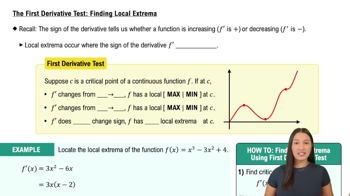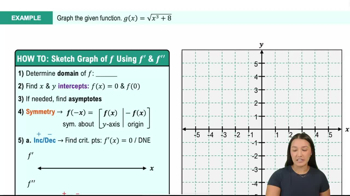Table of contents
- 0. Functions7h 52m
- Introduction to Functions16m
- Piecewise Functions10m
- Properties of Functions9m
- Common Functions1h 8m
- Transformations5m
- Combining Functions27m
- Exponent rules32m
- Exponential Functions28m
- Logarithmic Functions24m
- Properties of Logarithms34m
- Exponential & Logarithmic Equations35m
- Introduction to Trigonometric Functions38m
- Graphs of Trigonometric Functions44m
- Trigonometric Identities47m
- Inverse Trigonometric Functions48m
- 1. Limits and Continuity2h 2m
- 2. Intro to Derivatives1h 33m
- 3. Techniques of Differentiation3h 18m
- 4. Applications of Derivatives2h 38m
- 5. Graphical Applications of Derivatives6h 2m
- 6. Derivatives of Inverse, Exponential, & Logarithmic Functions2h 37m
- 7. Antiderivatives & Indefinite Integrals1h 26m
- 8. Definite Integrals4h 44m
- 9. Graphical Applications of Integrals2h 27m
- 10. Physics Applications of Integrals 2h 22m
5. Graphical Applications of Derivatives
Curve Sketching
Problem 4.3.104
Textbook Question
Designer functions Sketch the graph of a function f that is continuous on (-∞,∞) and satisfies the following sets of conditions.
f'(x) > 0, for all x in the domain of f'; f'(-2) and f'(1) do not exist; f"(0) = 0
 Verified step by step guidance
Verified step by step guidance1
Start by understanding the conditions given for the function f. The function is continuous on (-∞, ∞), which means there are no breaks, jumps, or holes in the graph of f.
The condition f'(x) > 0 for all x in the domain of f' indicates that the function is increasing everywhere it is defined. This means the slope of the tangent line to the graph of f is positive at every point where the derivative exists.
The points where f'(-2) and f'(1) do not exist suggest that there might be some kind of sharp turn or cusp at these points. The graph should reflect this by having a change in direction or a point where the slope is undefined.
The condition f''(0) = 0 implies that there is a point of inflection at x = 0. At this point, the concavity of the function changes. The graph should transition from concave up to concave down or vice versa at x = 0.
Combine all these conditions to sketch the graph: Start with an increasing function, ensure there are cusps or sharp turns at x = -2 and x = 1, and include a point of inflection at x = 0 where the concavity changes. Make sure the graph is smooth and continuous throughout its domain.
 Verified video answer for a similar problem:
Verified video answer for a similar problem:This video solution was recommended by our tutors as helpful for the problem above
Video duration:
4mPlay a video:
Was this helpful?
Key Concepts
Here are the essential concepts you must grasp in order to answer the question correctly.
Continuity of Functions
A function is continuous on an interval if there are no breaks, jumps, or holes in its graph. For a function to be continuous on the entire real line (-∞, ∞), it must be defined at every point and the limit of the function as it approaches any point must equal the function's value at that point. This concept is crucial for understanding the behavior of the function across its domain.
Recommended video:

Intro to Continuity
First Derivative and Monotonicity
The first derivative of a function, denoted f'(x), indicates the rate of change of the function. If f'(x) > 0 for all x in the domain, the function is increasing everywhere. The existence of points where f' does not exist, such as at x = -2 and x = 1, suggests potential vertical tangents or cusps, which can affect the overall shape of the graph.
Recommended video:

The First Derivative Test: Finding Local Extrema
Second Derivative and Inflection Points
The second derivative, f''(x), provides information about the concavity of the function. If f''(0) = 0, this indicates a possible inflection point at x = 0, where the concavity may change. Understanding the second derivative is essential for analyzing the curvature of the graph and predicting how the function behaves around critical points.
Recommended video:

The Second Derivative Test: Finding Local Extrema

 11:41m
11:41mWatch next
Master Summary of Curve Sketching with a bite sized video explanation from Callie
Start learning




